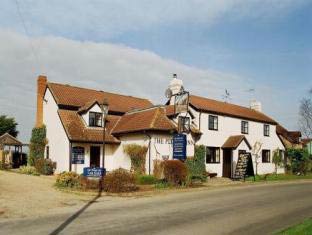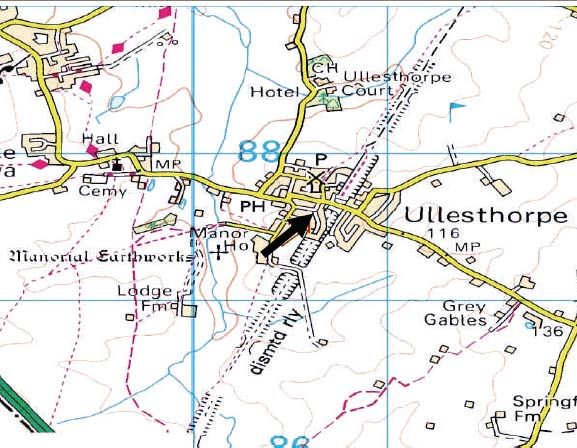World War II

The Plough Inn, Church Street, Earl Shilton ,where Joan Lyons[Turner] stayed to be near Ullesthorpe 1941/2 ; This was also the address given for Frank Lyons in the address book of his cousin, Arthur White.
During World War II there were 192 air raid alerts in Earl Shilton. World War II, or the Second World War, (often abbreviated WWII) was a global military conflict which involved a majority of the world's nations, including The first occurring on June 26th 1940 and the last on 20th March 1945. The village siren was erected on the factory of Toon and son in Wood Street, and known as ‘Moaning Minnie’.
The first bombing took place on the night of 20th – 21st November 1940, when three parachute mines were dropped. One landed in Barwell while the other two came down in the Northwest corner of Earl Shilton. One of these mines failed to explode, and both villages had a narrow escape as no one was injured and no serious damage was done. The following day a Royal Navy bomb disposal squad and blew the thing up at 3 pm. This left a good size crater near the ‘Brockey’, but soon afterwards this was filled in.
More incendiaries fell in Elmesthorpe on December 4th 1940. Chased across Shilton by the RAF, the German plane was brought it down near Leicester Forrest East. The Earl Shilton Home Guard were called out to the scene and prisoners were taken.
At 7am on July 27th 1942, a lone German bomber dived out of the clouds near the church and let go of three stick bombs. They landed at the back of Mr T Carter’s farm in Church Street, destroying a barn and badly damaging a house. Mr Carter had a very lucky escape himself, as he was out in his yard at the time only 20 yards (20 m) from the blast. A bull was so badly injured that it had to be put down. The plane went on to machine gun those unfortunate enough to be going to work.
Mr T J Langton recalls - I was at Earl Shilton R. C. School, in Mill Lane, when on this particular morning a lost German plane flew low over Keats Lane and as a boy I remember as Gary Cassell was on his way to the same school as this plane flew over, low and sprayed machine gun bullets along Keats Lane. He ran into an entry and dropped his scarf. When he eventually recovered it, he noticed it contained a bullet hole. He told the story to Michael Mortimore, the son of the village bobby who also attended the school. On hearing this, Mike Mortimore said 'It was a good job he had not got it wrapped round his neck, at the time. '
During the night of July 30th 1942, a 2000 lb bomb landed in Everards field near to Kings Walk, but apart from a pig being killed the bomb only rattled a few windows. The crater was still in evidence in 1947.
Mr T J Langton also recalls - I was woken up early one morning and was later told there had been an explosion, close by in Earl Shilton. Later that morning, it was discovered that a bomb had fallen in the Leacroft’s, and landing on soft ground restricted it’s damage to killing a pig and a chicken, belonging to the Fullylore family. It was later reported in newspapers, but owing to the war situation, it was not given out as being Earl Shilton, only ‘a Midland’s village’.
But it was not only the Germans that the villagers had to watch out for as a greenhouse in Huit Lane was hit by a stray anti-aircraft shell.
On the night of the big raid on Coventry planes passed over the village the whole night long. There was the distant sound of the anti aircraft batteries could clearly be heard and there was a huge orange glow in the sky, which marked the firestorm raining down on Coventry.
At the top end of the village, the Air Raid Patrol, ARP wardens, met in the back room of the Plough, a Public House run by Joe Lucas. They patrolled the streets checking the blackout and fire watching.
Hundreds of villagers went into munitions work, and eventually there was a munitions factory opened in the village. The village also took child refugees from Coventry, Birmingham and London.
Many villagers had shelters put in their gardens, but there were also public shelters in Wood Street, Station Road, Almey’s Lane, Keats Lane, The Hollow and Belle Vue.
The Local Defence Volunteers, later to be renamed the Home Guard, were organised in June 1940. They had their headquarters in a large house near Birds Hill called ‘Holydene’, the fire service and ambulance sharing a room here for a time. The Local Defence Volunteers were conspicuous in their denim overalls at the beginning of the war, but as time went on they were issued with army battle dress, tin hats, American rifles with bayonets and by the end of the war even boasted a couple of Lewis guns. One section of the Home Guard was on patrol every night and by the time they were stood down their strength had grown to 140 men. They were commanded in the early days by Captain Wileman and later by Major Wand of Desford.
Soldiers were billeted in most of the public buildings during the war. The military authorities requisitioned the Working Men's Club dance hall, the Adult School Hall, the Social Institute, Constitutional Club, and the Co-op village hall. After Dunkirk, the Sussex Yeomanry moved into the village, being replaced in turn by the Royal Army Ordnance Corps, Royal Artillery, Royal Marines and the Pioneer Corps. The Wesleyan Chapel in the Hollow was transformed into a British Restaurant, for the troops. Training was undertaken on the recreation grounds and other open spaces around the village. Mr Astley’s sand pit in Heath Lane was used as a shooting range.
There were around 900 men and women serving in the regular British forces, of which 25 were killed in action. Their names were duly added to the war memorial.
ULLESTHORPE
